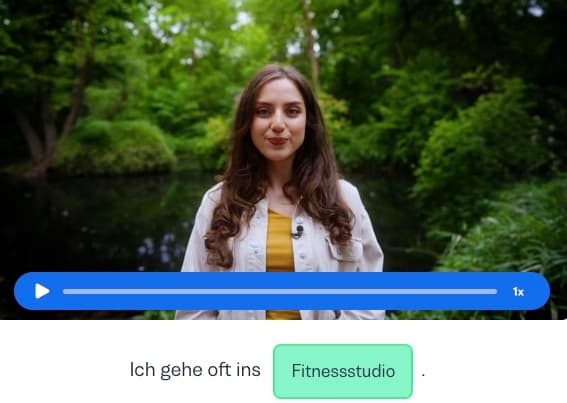I want to learn...
Mastering sentence structure in German is crucial for building appropriate phrases and effective communication. It's not just about memorizing general German sentence structure rules, but about developing the skills to form phrases and apply German word order correctly in different situations.
This is so important, since a different order can change the meaning or the small details that express different ideas.
If you have ever asked yourself how German sentence structure works, then you’re in the right place. We’ll show you what matters about German word order and how to form effective sentences for a variety of purposes. Let’s dive in!
Basic German sentence structure
Let’s get right to the point. As a general rule, every sentence in German has a subject (the person or thing performing an action) and a verb (an action), as in the following examples:
Ich esse. (I’m eating.)
Die Sonne scheint. (The sun is shining.)
Wir schlafen. (We’re sleeping.)
It doesn’t matter what’s happening, there is always a subject doing something. It's important to note that the subject calls the shots and determines the verb's ending –Ich esse, Die Sonne scheint, Wir schlafen. So, pretty much the same as we know it from English.
(Want to learn more about German verb endings? Take a look at our article on German verb conjugation.)
German negative sentence structure
In German negative sentence structure, the negative is usually expressed by the adverb nicht (not), which comes directly after the verb:
Ich esse nicht. (I don’t eat.)
Die Sonne scheint nicht. (The sun isn’t shining.)
Wir schlafen nicht. (We don’t sleep.)
Other information in sentences
Now, let’s spice up those sentences. In simple sentences, you can add other information to the sentence by simply putting it right after the verb:
An object: Ich esse einen Apfel. (I’m eating an apple.)
A time: Die Sonne scheint heute. (The sun is shining today.)
A location: Wir schlafen im Bett. (We’re sleeping in the bed.)
A special feature of German is that the subject is flexible. We can place the subject either before the verb (basic structure) or even after the verb when more information is included in the sentence, as you can see in the sentences above.
It is important to note that the verb always remains in position two, while the other information in the sentence moves before the verb. Let’s make this clear by having a look at the following examples:
Heute scheint die Sonne. (Today, the sun is shining.)
Einen Apfel esse ich. (I’m eating an apple. Literally translated: An apple I’m eating.)
Im Bett schlafen wir. (We’re sleeping in the bed. Literally translated: In the bed we’re sleeping.)
You can see that this type of word order is limited in English – in some cases it can work, but in other cases it doesn’t make much sense. However, in German this is a normal way to create sentences.
If you choose this sentence structure, you usually want to emphasize the object, time or place. For example, in the question and response below, the speaker wants to highlight the apple in their answer:
Question: Isst Du eine Birne? (Are you eating a pear?)
Response: Nein. Einen Apfel esse ich. (No. I’m eating an apple.)
Two basic rules to keep in mind
After what we’ve seen so far, we can already establish two basic rules for simple German sentences here:
Rule 1: The conjugated verb always comes in position two.
Rule 2: The subject always comes next to the verb, either before it, or after it when you want to emphasize other information at the beginning of the sentence.
Let’s go on to more extended phrases now.
Sentences with two objects
Two objects is double the fun! In German, there are sentences that contain both an indirect object (dative object) and a direct object (accusative object). In this case, the indirect object comes before the direct object.
In the English sentence, “I’m writing a message to my friend,” the direct object is “a message” and the indirect object is “my friend.” Let’s see how that applies in German:
Ich schreibe meinem Freund eine Nachricht. (I’m writing a message to my friend.)
Er zeigt mir die Wohnung. (He’s showing me the apartment.)
Wir kaufen den Kindern ein Geschenk. (We’re buying a present for the children.)
To keep it simple in the beginning, you can remember that in phrases with two objects the direct object is usually a person while the indirect object is a thing. That makes it easier to place the words in German correctly while having a conversation. All you have to do is remember to mention the person before the thing. This word order usually applies but may vary in spoken language or with emphasis.
Interested in brushing up on your German conversation skills? Check out our article on German conversation for daily life.
Sentences with more than one verb
Like in English, sometimes one verb just isn’t enough. German has some tenses and sentence constructions that use more than one verb. In such cases, there is a special word order in German.
German past tense sentence structure
In German, as in English, the perfect tense consists of two parts, the auxiliary verb sein (to be) or haben (to have), and the past participle (for example, eaten, been, gone).
When it comes to the word order in the sentence, there is an important difference from English – in simple sentences, the auxiliary verb is in position two and the past participle is at the end of the sentence. Check it out in these examples:
Ich habe einen Apfel gegessen. (I have eaten an apple. Literally translated: I have an apple eaten.)
Heute hat die Sonne geschienen. (Today the sun was shining.)
Wir haben im Bett geschlafen. (We have slept in the bed.)
While in English both verbs follow each other, they don’t in German. This rule is set in stone, which is why you should definitely memorize it. There can be as much information as you like between the two verbs, but their positions always remain the same. You can see this in the example below:
Ich habe heute Nachmittag gegen 12 Uhr einen Apfel in meinem Wohnzimmer gegessen. (I ate an apple in my living room this afternoon around 12 o'clock.)
Do you see? Between the auxiliary verb haben and the past participle gegessen, we can insert several details about time, place and objects, but there is no way we can change the verbs’ positions.
A classic mistake for native English speakers is to place both of the verbs next to each other in German. It’s not too terrible of a mistake since German native speakers will still understand the sentence. However, you can just stick to this rule and avoid word order mistakes easily.
German word order with modal verbs
The same applies if we want to use modal verbs, such as can, may, should, must and want. We use modal verbs with a second verb. In the simple form, the modal verb comes first, followed by the second verb:
Ich muss arbeiten. (I have to work.)
Ich will essen. (I want to eat.)
If further information is added, it is placed between the two verbs as in the perfect tense. The modal verb always remains in position two, and the second verb comes last:
Ich muss heute arbeiten. (Today, I have to work.)
Ich will einen Apfel essen. (I want to eat an apple.)
German question sentence structure
Questions with interrogative words
Are you curious about how to ask questions in German? Note the following easy tricks.
In questions with so-called ‘wh- words’ (questions that begin with words such as who, what, when, where and why), the question word always comes first, followed by the conjugated verb in position two, then the subject and finally any further information. If there is only one verb, the typical word order is seen in the following examples:
Wo wohnst du? (Where do you live?)
Was macht er? (What does he do?)
Wann kommst du nach Hause? (When do you come home?)
Wer hat die Bananen? (Who has the bananas?)
If you want to ask questions that are in the perfect tense or have a modal verb, the word order remains the same. Here, the second verb is in the last position:
Wo hast du vor 10 Jahren gewohnt? (Where did you live 10 years ago?)
Was hast du gestern gemacht? (What did you do yesterday?)
Wann kannst du nach Hause kommen? (When can you come home?)
Wer will eine Banane essen? (Who wants to eat a banana?)
Yes-no questions
Yes-no questions are used to find out whether something is correct or not. The answer is a clear yes or no. No question word is needed for this type of question. Instead, the verb comes first in the sentence, followed by the subject, and then further information:
Wohnst du hier? (Do you live here?)
Ist er dein Freund? (Is he your friend?)
Gehst du oft ins Kino? (Do you often go to the cinema?)
Sprichst du Deutsch? (Do you speak German?)
These sentences can also be formed in the perfect tense or with modal verbs, in which case the verb always comes first. As seen above, the second verb remains in its position at the end of the sentence. Here are some more examples:
Hast du in Paris gewohnt? (Did you live in Paris?)
Bist du gestern ins Kino gegangen? (Did you go to the cinema yesterday?)
Willst du ins Kino gehen? (Do you want to go to the cinema?)
Kannst du Deutsch sprechen? (Can you speak German?)
Complex German sentence structure
Let's now move on to a slightly more advanced topic – complex German sentences. Such sentences in German consist of a main clause and at least one subordinate clause.
The main clause is a complete sentence with a conjugated verb (for example, ‘I stay at home’), while the subordinate clause is dependent on a main clause and cannot stand alone (for example, “because it is raining”).
Subordinate clauses are introduced by a specific word like a conjunction (like ‘because’ or ‘even though’) or a relative pronoun (for example, ‘that,’ ‘who,’ or ‘where’).They fulfill various functions, such as specifying an action regarding time (“I’m going to stay at home before I go to the party”), place (“I like to stay at home where I can relax the best”), or condition (“I’ll stay at home if it rains”).
Many of these subordinate clauses have a special word order in German. In the following examples, the subordinate clause is always the second part of the sentence, after the comma. Pay special attention to where the verb is placed in the subordinate clause:
Ich gehe spazieren, obwohl es schon den ganzen Tag regnet. (I’m going for a walk even though it has been raining all day.)
Ich kann nicht arbeiten, weil ich krank bin. (I can't work because I am ill.)
Ich lese immer, bevor ich ins Bett gehe. (I always read before I go to bed.)
Ich muss dir sagen, dass ich heute Abend meinen Freund treffe. (I have to tell you that I am meeting my friend tonight.)
Das ist das Buch, das ich momentan lese. (This is the book that I am reading at the moment.)
Did you see what happens with the verb in German subordinate clauses? In German, the verb usually comes at the end of the subordinate clause, after all the other information. This rule stays the same across several types of subordinate clauses, whether they specify the time, conditions, place or something else.
This pattern might be a bit daunting in the beginning since it is so different from how you place the verb in English sentences. However, learning and using this rule will help you build and understand complex sentences better in German.
German sentence structure wrap-up
As we’ve seen, German sentence structure follows regular patterns, and understanding it is essential for appropriate communication. By applying the rules outlined here, you'll be able to successfully navigate German word order.
Now that we’ve covered basic German word order, contrasted German and English sentence structure, and highlighted some unique features, it’s time to practice and deepen your knowledge. With time, you're sure to become a pro at German sentence structure!
AUTHOR

Mathias Neubauer
Newlanguages


